100% Lab Grown Diamonds | Book Virtual Appointment

4Cs Of Diamond | Lab Grown Diamond Education
- Home
- Page
4C's Of Diamonds, BASICS and MORE
GIA created the first, and now globally accepted standard for describing diamonds: Color, Clarity, Cut, and Carat Weight – 4 C’s. This basic knowledge below will not only unlock the mystery of a diamond’s quality, but it will also help you understand a diamond’s value and price.
Diamonds are considered the world’s most precious gemstones.
They are traditionally used for engagement rings and other jewelry as a symbol of love and commitment. Buying a diamond is an important personal, financial and emotional decision. Our gemologists are experts on the subject and provide invaluable guidance so you can shop with confidence in a pressure free environment. So just sit back with a cup of coffee and let us walk you through everything you need to know before you buy that sparking diamond!
Diamond Color
All diamonds are colorless. The quality of a diamond is influenced by its transparency factor. A transparent diamond mostly allows light to pass through it which therefore results in creating a rainbow effect on it. But, necessarily all diamonds are not colorless or white, fancy colored diamonds found in hues of pink, blue, band yellow. Red being the rarest of all.
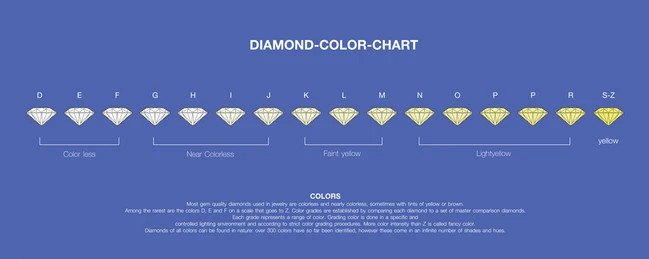
The GIA grades diamonds on a scale of D (colorless) through Z (light color). All D-Z diamonds are considered white, even though they contain varying degrees of color. True fancy colored diamonds (such as yellows, pinks, and blues) are graded on a separate color scale. To know, how gemologists grade diamond colors and how to pair a stone with a metal color for a setting, click here.
Diamond Clarity
Of all the 4 C’s “Clarity” is one of the most easiest characteristic of a diamond. When the diamonds are formed deep inside the earth, due to the pressure certain natural marks are spotted on it known as inclusions and blemishes. The clarity of a diamond is based on its inclusions and blemishes.
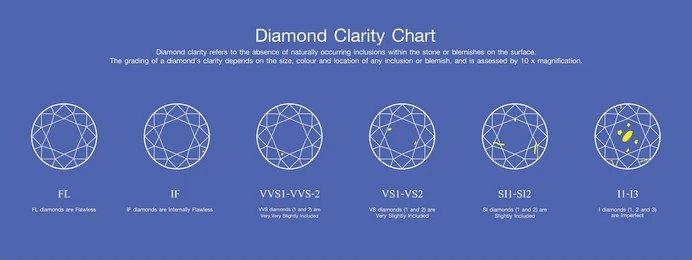
Some inclusions — tiny crystals and other features within gems — will have no impact on a diamond’s clarity grade and value. Others can negatively affect not only a diamond’s beauty but also its structural integrity. Sometimes, diamonds with low clarity grades can still be “eye clean” and might make great buys. Confused? Learn how to judge a diamond’s clarity for yourself. Learn about the diamond clarity – CHART AND SCALE.
Diamond Cut
According to gemologists, cut is the main aspect of a diamond. A cut of a diamond forms its facets, brings evenness, and verifies the brilliance of a diamond. A well-cut diamond allows light to penetrate and pass through it thereby reflecting much light and making it more sparkling. The more the cut is brilliant the more luminous is the diamond. The beauty of a diamond is solely dependent on the cut.
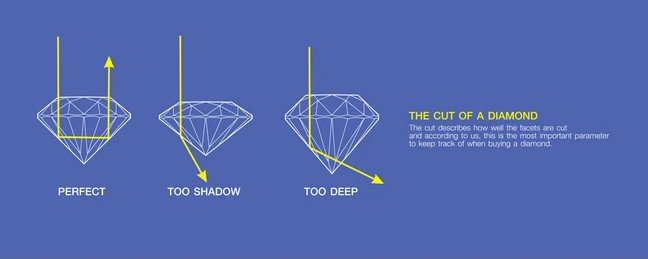
The cut is often considered the most important of the 4 C’s of diamonds (carat is more of a preference, not an art or science). When selecting a diamond, it will certainly be important to ensure light is not lost. Excellent cuts are most premium and Very Good cuts offer more value. The differences in sparkle are quite subtle, but they are noticeable when compared side by side. We recommend maximizing the Cut grade, if possible. See our Diamond Cut Guide for more in-depth information.
Diamond Carat
The weight of a diamond is measured in “Carat”. The carat of a diamond denotes its size. The word “carat” has been derived from the word the carob seeds which people used in to weigh their balance scales. The short form of carat is “CT” and “TCW” stands for total carat weight. A carat includes 100 ‘points’ and a jeweler defines the weight of a diamond below a carat by its “points”. Supposedly, if a diamond weighs 0.40 carats it is thereby declared as a “forty pointer.”
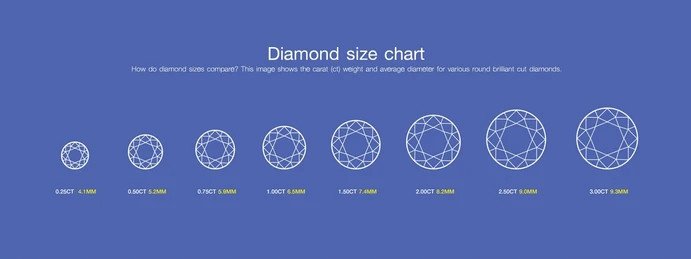
Diamonds are sold by the carat (shown as ct.), which is actually a unit of weight, though most think of a carat in terms of size. The word “carat” comes from the “carob” seed, the original unit of measure for diamond traders. Today, a carat is equal to exactly 0.2 grams (about the weight of a paper clip). Carat weight is unrelated to the similar sounding karat, which refers to gold’s purity. Learn more about Carat Sizes
Diamond Shapes & Cuts
Virtually all Diamond Cuts sold for use in jewelry are one of ten round or fancy Diamond Shapes. The most popular diamond shapes are:
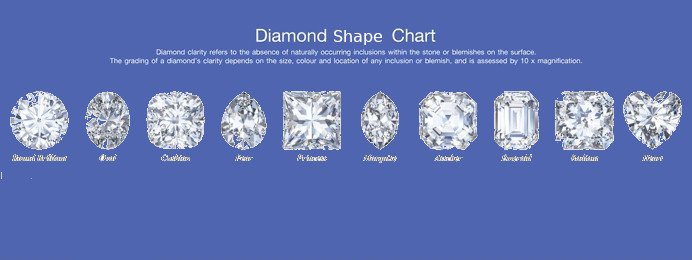
Diamonds are sold by the carat (shown as ct.), which is actually a unit of weight, though most think of a carat in terms of size. The word “carat” comes from the “carob” seed, the original unit of measure for diamond traders. Today, a carat is equal to exactly 0.2 grams (about the weight of a paper clip). Carat weight is unrelated to the similar sounding karat, which refers to gold’s purity. Learn more about Carat Sizes
The Anatomy of a Diamond
Each diamond has specific properties which are called the Anatomy of a Diamond. The three most important components diameter, table, and depth form the basic structure of the diamond. To know better, here’s the guide to identifying the structure of a Diamond.
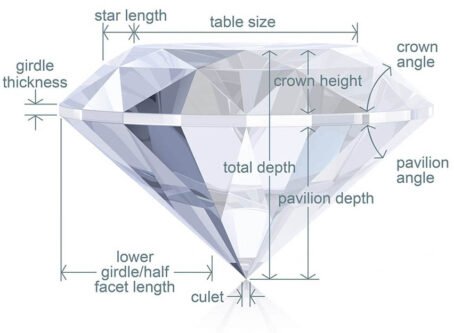
Once cut and polished, all diamonds possess a shared set of characteristics, often referred to as the anatomy of the diamond. While the individual proportions, angles, and placement of these common characteristics vary for diamonds of different shapes, their definition is the same. An entire portion of the diamond sits above the girdle. Learn about The Anatomy of a Diamond
Diamond Certification
A diamond certificate is a document also known as a diamond grading report graded by renowned gemologists that include the genuine features of a diamond. After a diamond is being thoroughly studied, scrutinized, and evaluated, the attributes are then measured and noted on the diamond certificate and presented along with the diamond. A certificate given from a gemological laboratory verifies the quality of a diamond and allows non-experts to make knowledgeable decisions while purchasing diamonds.

Many consumers wonder why it is that some diamonds or other precious gemstones come with charts, certificates, or extensive packets of information upon purchase, but others only come with a receipt and a “thank you the shopper.” While you can request any information related to a diamond you intend to purchase, and you can get copies of information on one you choose, the more thorough (thick or hefty) reports and certificates are reserved for diamonds that have received an official certification, or “certified diamonds.” Diamonds and other gemstones receive certifications through gemological institutions that carefully evaluate, compare, and rate them for quality and consumer demand. Non-certified diamonds may have ratings or accompanying documentation, but they haven’t received an official certificate from an institute, such as the GIA, or the Gemological Institute of America.

